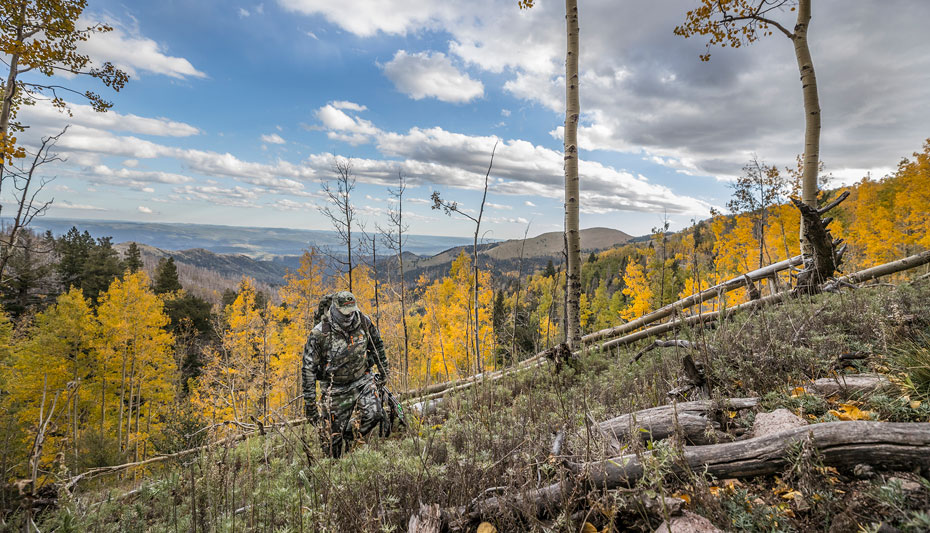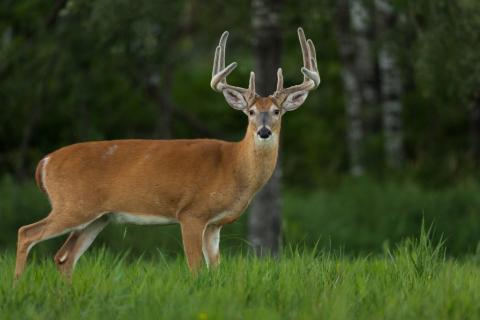
How to Prepare for an Elk Hunt
Before you even get to your destination, you need to prepare for your elk hunt. Scott Hatch from Three Forks Ranch in Colorado advises first-time elk hunters to get in shape. You need to get physically fit well in advance of your hunt. Once you get there, you will need to get acclimated to the altitude, so don’t overdo your climb even if you are physically ready. The Mossy Oak Country Roots 20L Hunting Backpack from Walmart is water bladder compatible to help you stayed hydrated before, during and after the hunt.
When it comes to being prepared for an upcoming elk hunt there are many things to consider. Here are four things to consider before you head out:
Elk hunting is a physical, strenuous hunt and you never really know what it might require. There is a small chance you could find yourself hunting a water hole or sitting on meadow, but more than likely you will be hiking, chasing, and pursuing elk! For every step you take the elk takes four. It’s steep, there isn’t much air, and to top it off, you need to achieve everything in record time. Being as physically fit as possible can dramatically increase your opportunity at a successful elk hunt.
With that being said, you definitely don’t have to be a bodybuilder or fitness guru, but having your legs under you and decent cardio will go a long ways. To keep it simple, here are the basics to physical success. The average elk hunter probably walks between two and four miles a day. So, in the weeks leading up to hunt I could try and walk that same two to four miles each day. Being that the hunt will be fast pace, I would time yourself casually walking two miles. Once you have that time, take 25 percent off of that time and try and hold yourself at that pace for your entire walk. On top of your fast-paced walk, I would load my hunting pack as if I was going out on a hunt. I would carry that same weight each and every time I hike or walk to prepare your body for the upcoming hunt.
Shop Now: Mossy Oak Tech Pullover Hoodie
Hydrate This is the number one thing that will help a person prepare for an elk hunt, or any strenuous activity for that matter. Each and every individual should double and in some cases triple their water intake in the month before the hunt. Being hydrated will lower the chance of altitude sickness, prevent cramping, build energy, and generally make you feel better on the hunt. I also mix in 12 ounces of coconut water to hydrate each day before hiking.
Practice situationally. We do a ton of work on a hunt and it all boils down to a few seconds when it’s time to take the shot. The shot is everything! Learning to be prepared, be comfortable, and be quick is a major portion of success. Take bow hunting for example. A hunter that uses a single pin sight has to create movement in the final seconds to adjust his pins to the distance at which the animal is at or will be. This costs you time and worry of being seen. A multi-pin sight allowing a hunter to range multiple points and be prepared as the elk stops at these points saves time. With the concept of bow hunting, it is fairly common to see a bow hunter not from the Rocky Mountain region take off their quiver when shooting. A hunter that must take off their backpack and or quiver to take the shot causes movement and slows down the process. To create the most success for yourself you should be able to shoot with a backpack on and without removing any accessories. The Mossy Oak Country Roots 29L Hunting Backpack is just that. Easy to get into different compartments, waist belt with zipper pockets for easy access to lights, ammo, etc.., weapon holder and much more.
Eliminate foreign noise. During the 10 years that I guided elk hunts it never failed that the first 3 hours of first day I would walk behind my guests fixing zippers, dumping water bottles, getting rid of pocket change, etc. Do yourself a favor. Get dressed and packed and have your wife, kids, husband, friend whoever, listen and eliminate all foreign noise.
How To Age An Elk
Scott Hatch has been chasing elk for years, and he ages elk by their antlers, body size and shape, and head position. Usually, the bigger and heavier the antlers, the more mature the bull elk. Mature bulls also have a swayback in the lower neck, a bigger hump and a lower head. If it looks like a big yellow bus, it’s a mature elk. Some say you can hear it in the bugle, but that shouldn’t be used to determine age. Only laying eyes on the elk can give you a good idea of its age.
To truly judge the age of a bull would be to check teeth, but over the past 20 years of hunting elk extremely hard, I have always struggled to peek in the mouth of a living bull. So, we turn to other methods that will give us a rough idea.
An older bull will generally be lighter in color, have rougher, coarse hair, generally has swaying or more curvature in its antlers in between the points, has more color around its eyes, and lastly has a more defined hip bone on his rear quarter. As a hunter who studies bulls in the Rocky Mountain Region, I see various bulls aged between 10 and 15 years old. Some older and younger but a lot in that range. A bull’s patterns and lifestyle will dramatically affect their age. A bull that ruts hard, migrates a large distance to its wintering grounds, deals with harsh winter conditions, including deep snow, will have a shorter lifespan than a bull that ruts lighter, migrates only a few miles, and lives in a warmer less harsh environment with good food through winter.
Antler growth can get you in the ball park but not all the way. In the Colorado regions where I watch and study bulls, the average animal is in his prime rutting stage and has his peak antler growth between the ages of seven and nine. This is important to know because some bulls in good genetic areas will look amazing at age four yet still have a long ways to go. With that same thought an old bull at 10 or 12 years might be well beyond prime and have half the antler growth it once had, but people might assume he is young when really he is old.
My best example: I watched and hunted a large bull elk here in Colorado for many, many years. This bull reached his prime at age eight. Rough field judging combined with measurements of his sheds produced a rough score of 385 inches on this bull elk. At age 12, with sheds and field judging, he was around 290 inches of antler. That is a very large swing in growth as the bull aged.
Elk Calling Tips | Early Season vs. The Rut
When it comes to calling elk there are a few simple rules to follow. All states, regions, herds, even valley to valley can be different and provide different situations to manage. I have seen public land areas that are near major cities get hunted hard and the elk have been over-called. These bulls literally will not make a sound in daylight hours. Then you have areas with less pressure or bulls that simply don’t care, and these animals will bugle and cow call to anything. Since there is so much diversity in these situations following these rules will lead you to success.
First and foremost, do what the elk are doing. If the elk are talking, you should be talking. If the elk are not talking, you should not be talking. It sounds simple, but this is the best advice you can get.
Think of it like this: if you are at a store or restaurant and everyone is having a conversation, you blend in, no harm no foul. However, if that same store or restaurant and is dead silent and you start talking loudly, everyone in there will be alarmed by the fact that you are talking when obviously there is a reason for silence. When you see bulls but do not hear them, revert to spot-n-stalk or hunting water holes.
When you can call, less is more. Being the shy innocent type can draw a lot of attention. Almost a curiosity killed the cat type situation. This goes for both cow calls and bugles. Bugling to an active bull is probably the ultimate of all hunting experiences. It’s an adrenaline-pumping situation. And when the blood is flowing and the excitement is rolling, it is very easy to get caught up and be too aggressive. So I approach every calling situation with the concept of less is more, and the bigger I build the approaching bull’s ego the better! I try and respond to the bugles as if I really do care, but when I answer I want to sound weak and timid. I want the approaching bull to have confidence that he can kick my butt. If you give a bull confidence, that is a bull that will come charging in to mere feet from you producing the best shot.
However when you are very aggressive with your calling that bull will harbor a bit of fear. A fearful bull crouches much slower, looks around more often, and sometimes stops just outside of shooting range trying to figure out the situation. The last thing a bull ever wants to do is lose a battle and lose his cows. Being the lesser animal will greatly increase your odds.
Bow Hunting vs. Rifle Hunting for Elk
A bow cannot cover as much ground as a rifle. Therefore, bowhunting requires the hunter to get in close. When you set up to bowhunt elk, put the hunter between the elk and the caller. Rifle hunting for elk allows you to hang back and glass a mountain to find the elk and then move in a little closer to make the shot. Check with your outfitter before the elk hunt to determine whether you can bowhunt, rifle hunt or both.
Morning vs. Afternoon Elk Hunting
It’s a matter of preference, typically, but there are things to consider when choosing a time of day to hunt elk. Morning hunts give you more time to get the elk packed out, take pictures with your trophy and just enjoy the moment. Evening hunts feel more rushed, because you want to get back to camp before the temperatures drop. To have success elk hunting, you have to know wind direction. Elk usually go up and want to get where the winds are changing so they can smell. They cover a lot of ground, and you want to get even with them or above them.
Afternoon Elk Hunting Tips
Early season elk hunting can be hot in the afternoon and early evening. Look for water because that’s where elk will be headed. It gets dark quickly, so don’t be afraid to move. Head to water, pay attention to the wind, call, move if necessary, be aware of losing light, and rely on previous experience, which is a lot of what hunting is about. If it’s your first evening elk hunt, even if you end up empty-handed, there’s always something to learn.




















